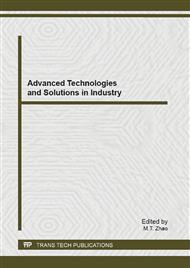[1]
R. Plamondon and S. Srihari, On-line and off-line handwriting recognition: A comprehensive survey, IEEE Transactions on Pattern Analysis and Machine Intelligence, 22(1):63-84, 2000.
DOI: 10.1109/34.824821
Google Scholar
[2]
C. Johnson, A survey of current research on online communities of practice, The internet and higher education, 4(1):45-60, 2001.
Google Scholar
[3]
T. Tokumoto and S. Ozawa, "A property of learning chunk data using incremental kernel principal component analysis," in Evolving and Adaptive Intelligent Systems (EAIS), 2012 IEEE Conference on, 2012, pp.7-10.
DOI: 10.1109/eais.2012.6232796
Google Scholar
[4]
S. Liwicki, G. Tzimiropoulos, S. Zafeiriou, and M. Pantic, Euler Principal Component Analysis, International Journal of Computer Vision:1-21, 2012.
DOI: 10.1007/s11263-012-0558-z
Google Scholar
[5]
G. F. Lu, J. Zou, and Y. Wang, Incremental learning of complete linear discriminant analysis for face recognition, Knowledge-Based Systems, 2012.
DOI: 10.1016/j.knosys.2012.01.016
Google Scholar
[6]
G. F. Lu, J. Zou, and Y. Wang, Incremental complete LDA for face recognition, Pattern Recognition, 2012.
DOI: 10.1016/j.patcog.2012.01.018
Google Scholar
[7]
J. Yang, Z. Shi, and P. A. Vela, "Person Reidentification by Kernel PCA Based Appearance Learning," in Computer and Robot Vision (CRV), 2011 Canadian Conference on, 2011, pp.227-233.
DOI: 10.1109/crv.2011.37
Google Scholar
[8]
Y. Choi, T. Tokumoto, M. Lee, and S. Ozawa, "Incremental two-dimensional two-directional principal component analysis (I (2D)<sup> 2</sup> PCA) for face recognition," in Acoustics, Speech and Signal Processing (ICASSP), 2011 IEEE International Conference on, 2011, pp.1493-1496.
DOI: 10.1109/icassp.2011.5946776
Google Scholar
[9]
X. Qiao, R. Xu, Y. Chen, T. Igarashi, K. Nakao, and A. Kashimoto, Generalized N-Dimensional Principal Component Analysis (GND-PCA) Based Statistical Appearance Modeling of Facial Images with Multiple Modes, Information and Media Technologies, 4(4):999-1009, 2009.
DOI: 10.2197/ipsjtcva.1.231
Google Scholar
[10]
H. Lu, K. Plataniotis, and A. Venetsanopoulos, MPCA: Multilinear Principal Component Analysis of Tensor Objects, IEEE Transactions on Neural Networks, 19(1):18-39, 2008.
DOI: 10.1109/tnn.2007.901277
Google Scholar
[11]
J. Kwok and H. Zhao, "Incremental eigen decomposition," presented at the Proceeding of Internet Corporation for Assigned Names and Numbers, Turkey, 2003.
Google Scholar
[12]
P. Belhumeur, J. Hespanha, and D. Kriegman, Eigenfaces vs. fisherfaces: Recognition using class specific linear projection, IEEE Transactions on Pattern Analysis and Machine Intelligence, 19(7):711-720, 1997.
DOI: 10.1109/34.598228
Google Scholar
[13]
P. Hall, D. Marshall, and R. Martin, Merging and splitting eigenspace models, IEEE Transactions on Pattern Analysis and Machine Intelligence, 22(9):1042-1049, 2000.
DOI: 10.1109/34.877525
Google Scholar


